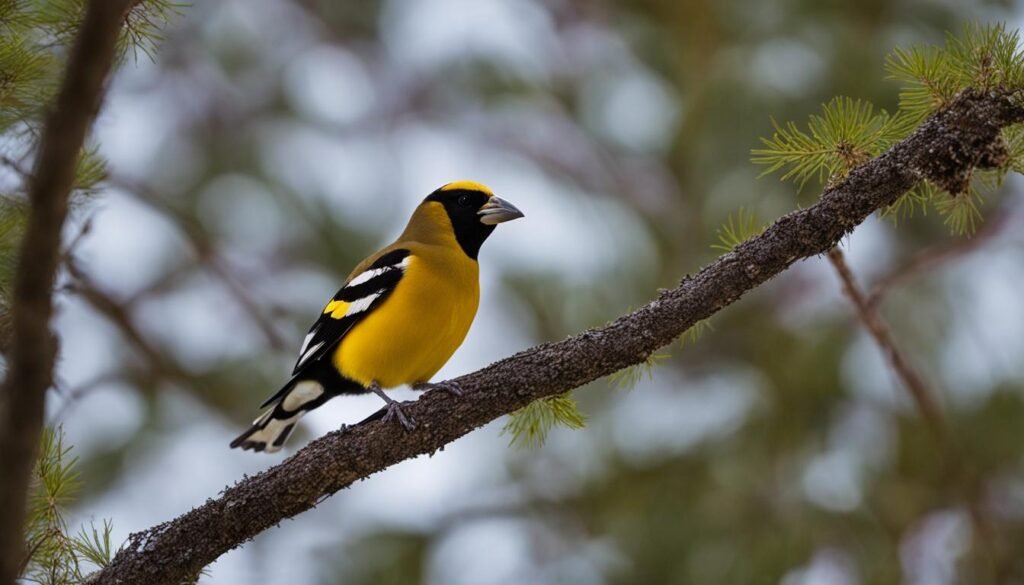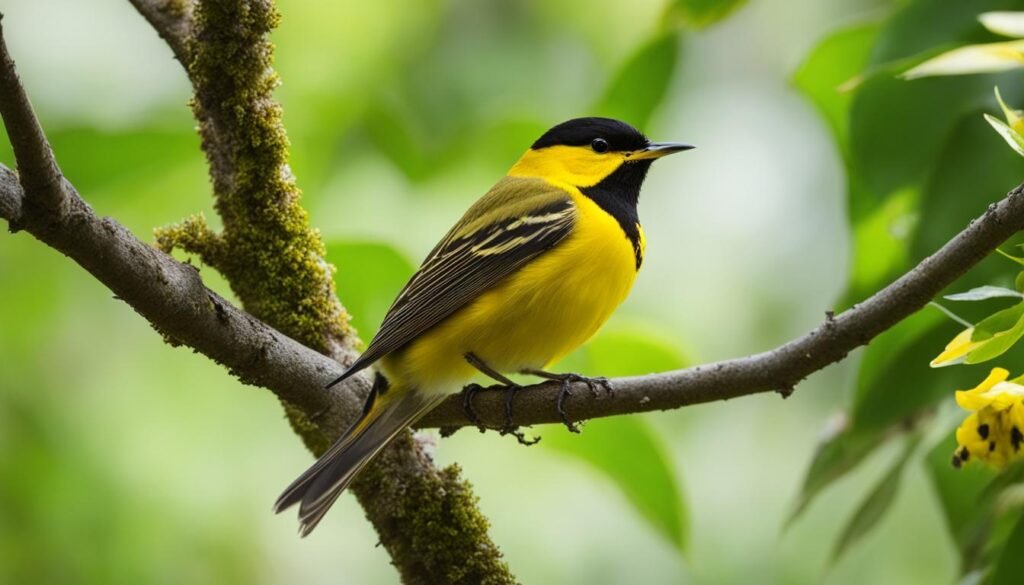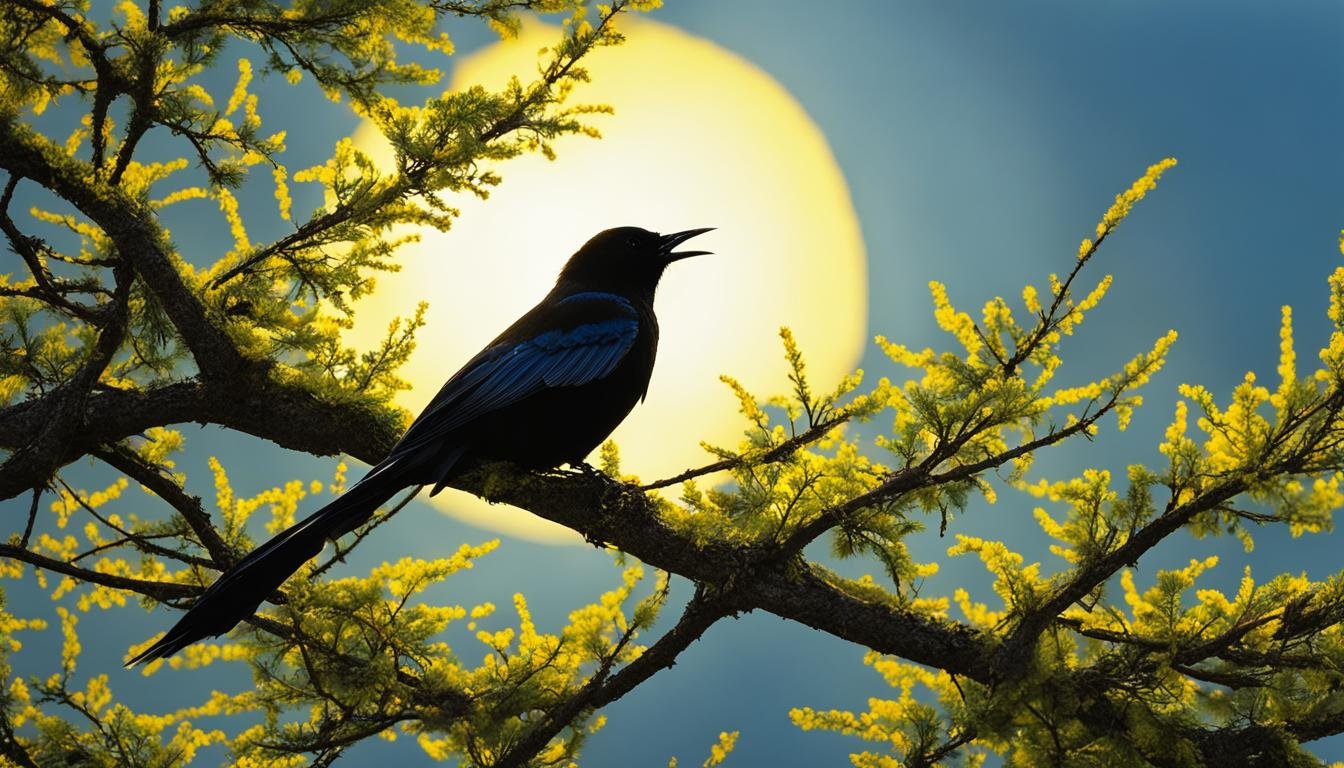Hi there! Welcome to my guide on yellow black winged birds, a fascinating and visually striking species that has captured the attention of bird enthusiasts and nature lovers alike. In this comprehensive guide, I will take you on a journey to explore the world of these beautiful birds, their habitats, behaviors, and conservation status.
Yellow black winged birds are truly a marvel to behold. With their vibrant yellow plumage and contrasting black wings, they possess a unique aesthetic that sets them apart from other bird species. These birds showcase nature’s artistry and have captivated our imagination for centuries.
Throughout this guide, we will unravel the science behind their vivid coloration, including the role of carotenoids in producing their yellow plumage and the significance of melanin in creating their dark wings. We will also explore the diverse habitats where these birds can be found, ranging from open fields to woodlands and marshlands.
But it’s not just about their stunning appearance and habitats. I will delve into the various species of yellow black winged birds found in America and beyond, highlighting their distinctive traits, behaviors, and conservation concerns. We’ll also take a closer look at their feeding habits and the symbolic significance they hold in different cultures.
Now, let’s embark on this exciting journey together as we discover the wonders of yellow black winged birds and learn how we can contribute to their conservation efforts. So, grab your binoculars and let’s get started!
Key Takeaways:
- Yellow black winged birds have a captivating aesthetic with their bright yellow plumage and contrasting black wings.
- Their vivid coloration is a result of carotenoids in their feathers and melanin in their wings.
- These birds can be found in various habitats, from open fields to woodlands and marshlands.
- Different species of yellow black winged birds exist in America and all around the world, each with its own unique characteristics.
- Understanding their feeding behaviors and cultural symbolism contributes to our appreciation of these remarkable birds.
The Allure of Yellow Black Winged Birds in Nature
When it comes to birds, few species capture our imagination quite like the yellow black winged birds. With their vibrant plumage and striking contrast of colors, these birds are a sight to behold. The allure of their appearance has fascinated bird enthusiasts and nature lovers for centuries.
The beauty of their yellow and black plumage is truly captivating. The bright yellow feathers, contrasted with the deep black wings, create a visual appeal that is hard to ignore. Whether it’s the American goldfinch with its bold yellow and black markings or the evening grosbeak with its unique color variations, these birds stand out in any natural setting.
It’s not just their colors that make yellow black winged birds visually appealing. Their graceful flight and elegant movements add to their charm. Watching these birds in flight, with their wings spread wide, is a mesmerizing sight that brings joy to observers. Their yellow and black feathers seem to dance in the air, creating a spectacle that leaves us in awe.
“The beauty of the black and yellow bird species lies not only in their appearance but also in the emotions they evoke. The sight of these birds can bring a sense of serenity and wonder, reminding us of the beauty and diversity of the natural world.”
The visual appeal of black and yellow bird species goes beyond their individual beauty. These birds also play a significant role in ecosystems as pollinators, seed dispersers, and insect controllers. Their presence enhances the overall biodiversity and adds vibrancy to our surroundings.
To provide a glimpse of the allure of yellow black winged birds, take a moment to admire this stunning image:
As you can see, the captivating colors and elegant form of this black and yellow bird species truly make it a visual masterpiece.
In the following sections, we will delve deeper into the science behind their vivid coloration, explore their habitats, learn about different species found across America and beyond, examine their feeding behaviors, and understand their cultural significance. Join me on this journey as we unravel the mysteries of these captivating creatures and gain a greater appreciation for the allure of yellow black winged birds in nature.
Understanding the Science Behind Their Vivid Coloration
In order to truly appreciate the vibrant yellow plumage and striking black wings of yellow black winged birds, it is important to understand the science behind their coloration. These birds have evolved unique mechanisms that allow them to display such remarkable colors.
The Role of Carotenoids in Yellow Plumage
Carotenoids are the key pigments responsible for the breathtaking yellow plumage seen in these birds. These compounds are naturally occurring organic pigments found in various plants, fruits, and vegetables. When yellow black winged birds consume diet rich in carotenoid-containing food sources, their body absorbs these pigments and transports them to the feathers during the molting process.
The carotenoids then bind to the feathers, resulting in the vibrant yellow coloration that is characteristic of these birds. The intensity of the yellow hue can vary depending on factors such as the type and quantity of carotenoids consumed, as well as the bird’s overall health and genetic makeup.
Why Wings Go Dark: The Melanin Factor
While the yellow plumage steals the show, the dark black wings of yellow black winged birds also play a crucial role in their overall appearance. The coloration of their wings is primarily determined by a pigment called melanin.
Melanin is a dark brownish-black pigment that is responsible for producing the dark coloration in various parts of the birds’ body, including their wings. Melanin is produced by specialized cells called melanocytes, and its presence in the feathers creates the dark black hue that contrasts with the vibrant yellow plumage.
The amount of melanin present in the wings can vary among individuals and species, resulting in variations in the shade of the black. Factors such as age, stress, and environmental conditions can also influence the development of melanin in the feathers, further contributing to the unique patterns and appearances of these birds.
Exploring Habitats of Birds With Yellow and Black Feathers
In this section, we will dive into the fascinating habitats of birds with yellow and black feathers. These environments provide the necessary resources and conditions for these vibrant bird species to thrive.
Yellow black winged birds can be found in a variety of habitats, each with its own unique characteristics and features. Let’s take a closer look at some of these habitats:
Open fields: These expansive grassy areas are home to several species of yellow black winged birds. The open spaces offer ample foraging opportunities and provide an ideal habitat for ground-nesting birds.
Woodlands: Forested areas provide shelter, nesting spots, and abundant food sources for these birds. The dense vegetation and diverse tree species create a thriving ecosystem that supports a wide range of bird species.
Marshlands: Wetlands and marshes offer a rich and diverse habitat for yellow black winged birds. These areas provide important breeding grounds and attract a variety of insects and invertebrates, which serve as a food source.
The specific characteristics of each habitat play a crucial role in the survival and well-being of these bird species. From open fields to woodlands and marshlands, each environment offers unique resources and challenges that shape the behavior and adaptation of these birds.

By understanding the environments that yellow black winged birds call home, we can gain a deeper appreciation for their remarkable adaptations and the interconnectedness of ecosystems.
Yellow Black Winged Bird: Identifying Species Across America
In America, you can find a variety of yellow black winged bird species that showcase the stunning combination of vibrant yellow plumage and contrasting black wings. These birds possess unique physical characteristics, behaviors, and habitats, making them fascinating subjects for bird enthusiasts. In this section, I will introduce you to three notable yellow black winged bird species found in America: the American Goldfinch, the Evening Grosbeak, and Warblers.
The American Goldfinch: Bright and Bold
The American Goldfinch, also known as Spinus tristis, is a small songbird that can be easily identified by its bright yellow plumage and black wings with striking white wing bars. These birds are a common sight throughout America and are often found in open fields, meadows, and grasslands. The American Goldfinch is known for its lively and cheerful song, which adds to its charm. These birds have a preference for seeds, especially those of sunflowers and thistles.
The Evening Grosbeak’s Declining Numbers

The Evening Grosbeak, scientifically known as Coccothraustes vespertinus, is a stunning yellow black winged bird species that has been facing declining numbers in recent years. These birds have a unique color pattern, with vibrant yellow plumage on their body and striking black wings. The Evening Grosbeak is known for its large beak, which it uses to crack open seeds and fruits. These birds can be found in coniferous forests across America and are known for their flocking behavior.
Warblers: The Flying Jewels of the Forest

Warblers are a diverse group of small songbirds that come in various colors and patterns. Several warbler species exhibit the characteristic yellow black winged coloration, making them a part of our discussion. These birds are often referred to as the “flying jewels of the forest” due to their vibrant plumage and active nature. Warblers can be found in various habitats across America, including forests, wetlands, and gardens. Their diet mainly consists of insects, and they are known for their beautiful songs.
Identifying yellow black winged birds in America can be an exciting and rewarding experience. By familiarizing yourself with the American Goldfinch, Evening Grosbeak, and Warblers, you can enhance your bird-watching adventures and appreciate the beauty of these remarkable species.
Yellow and Black Winged Bird Species Beyond Borders
In addition to the vibrant yellow and black winged bird species found in America, there are also fascinating species from other parts of the world. Let us explore two remarkable examples of these avian beauties: the Eurasian Golden Oriole and the Lesser Goldfinch.
Eurasian Golden Oriole: Beauty Across Continents
 The Eurasian Golden Oriole is a stunning bird known for its striking yellow and black plumage. Found in various countries across Europe, Asia, and Africa, this species captivates birdwatchers with its vibrant colors and melodious song.
The Eurasian Golden Oriole is a stunning bird known for its striking yellow and black plumage. Found in various countries across Europe, Asia, and Africa, this species captivates birdwatchers with its vibrant colors and melodious song.
The Eurasian Golden Oriole prefers wooded areas, especially deciduous forests, where it can easily hide amidst the foliage. Its unique bright yellow feathers allow it to blend in with the surrounding greenery while its contrasting black wings add a touch of elegance.
The Lesser Goldfinch’s Subtle Elegance
The Lesser Goldfinch is a small but enchanting bird with yellow and black plumage. It can be found in various regions throughout the Americas, including North, Central, and South America.
This species is known for its subtle elegance, with its yellow underparts and back, contrasted by black wings and cap. The Lesser Goldfinch is often seen darting among shrubs and trees, foraging for seeds and insects.
Both the Eurasian Golden Oriole and the Lesser Goldfinch exemplify the global diversity of yellow and black winged birds. Their striking colors and unique adaptations make them truly remarkable creatures in their respective habitats.
Feeding Behaviors of Black and Yellow Birds
When it comes to the feeding behaviors of yellow black winged birds, their diet and foraging habits play a crucial role in their survival and ecological role. These birds have diverse dietary preferences and employ various foraging techniques to obtain their food.
Diet of Black and Yellow Bird Species:
Yellow black winged birds have a varied diet that consists of seeds, berries, insects, and nectar. They are opportunistic feeders, adapting their diet based on the availability of food sources in their habitats. By consuming a combination of plant matter and animal prey, these birds meet their nutritional needs and contribute to the dispersal of seeds and control of insect populations.
Yellow black winged birds display different foraging techniques depending on their specific species and habitats. Some species, like warblers, are highly agile and active, swiftly moving through vegetation to capture insects. Others, such as finches, employ a more methodical approach, carefully selecting seeds or berries from plants.
These birds may also have specialized adaptations to aid in their foraging. For instance, certain species have unique beak shapes that allow them to access nectar from flowers or extract insects from tree bark. These adaptations have evolved over time to optimize their feeding efficiency and exploit specific food resources.
By understanding the feeding behaviors of yellow black winged birds, we gain insight into their ecological roles and the intricate relationships they have with their habitats. From seed dispersal to insect control, these birds contribute to the balance and health of their ecosystems.
The Symbolism of Yellow and Black Colored Birds
In many cultures around the world, yellow and black colored birds hold significant symbolic meaning. These birds, with their vibrant plumage and contrasting colors, are often associated with luck, prosperity, and positive energy.
Luck and Prosperity: The Folklore Connection
Yellow and black birds have long been believed to bring good luck and fortune. In folklore and mythology, they are often seen as symbols of abundance and prosperity. Their presence is thought to herald positive news, blessings, and successful endeavors.
“Legend has it that spotting a yellow and black bird flying near your home is a sign of impending good fortune. It is said to bring luck and success in your personal and professional life.”
These birds are also believed to have the power to ward off evil spirits and negative energies. In many cultures, they are often depicted as protectors, bringing a sense of security and well-being to those who encounter them.
Yellow Black Winged Bird in Culture
The cultural significance of yellow and black bird species can be observed in various artistic expressions, folklore, and traditions. They have been featured in paintings, songs, poems, and even national emblems.
For example, in some Native American cultures, the American Goldfinch, with its striking black and yellow feathers, is revered as a sacred bird. It is seen as a symbol of joy, happiness, and the divine connection to nature.
In Chinese culture, the Eurasian Golden Oriole, with its bright yellow plumage, is considered a symbol of good fortune and prosperity. Its melodious song is believed to bring harmony and peace to the surroundings.
Through their presence in cultural narratives, these birds have become iconic symbols, representing various positive qualities such as happiness, abundance, and success.
Conservation Status: Protecting the Yellow Black Winged Bird
Conservation plays a crucial role in ensuring the survival and well-being of yellow black winged birds. These remarkable species, with their vibrant plumage and unique characteristics, are facing various threats in the wild. As passionate bird enthusiasts and stewards of nature, we must come together to protect and preserve these beautiful birds for future generations.
Efforts are underway to safeguard the conservation of yellow black winged birds through a range of initiatives. One key focus is habitat restoration, which aims to create and maintain suitable environments for these birds to thrive. By restoring degraded habitats and preserving their natural ecosystems, we can provide the necessary resources and nesting areas these birds require.
Population monitoring is another critical aspect of bird conservation. By actively monitoring yellow black winged bird populations, researchers and conservationists can gather valuable data on population trends, distribution patterns, and behavioral changes. This knowledge allows for targeted conservation actions and the implementation of strategies that address specific conservation concerns.
Conservation initiatives are not limited to scientists and researchers alone. Public awareness campaigns are essential in spreading knowledge and promoting community involvement in bird conservation. By educating the public about the conservation needs of yellow black winged birds and the significant role they play in ecosystems, we can foster a sense of stewardship and inspire action.
Protecting yellow black winged birds is not just about preserving these species; it is also about safeguarding the biodiversity and ecological balance of our planet. Birds contribute to important ecosystem functions such as pollination, seed dispersal, and insect control. By conserving their populations and habitats, we are ensuring the health and resilience of our natural world.
As individuals, we can contribute to bird conservation efforts by creating bird-friendly spaces in our own backyards and communities. Planting native vegetation, providing clean water sources, and avoiding the use of harmful pesticides are simple actions that can make a significant difference in supporting these birds.
Together, through collaborative conservation initiatives and individual actions, we can protect the yellow black winged bird species and secure their place in our shared natural heritage.
Conclusion
Throughout this yellow black winged bird guide, I have taken you on a journey to discover the fascinating world of these beautiful creatures. We have explored the allure of their vibrant plumage and discussed the science behind their vivid coloration. From their diverse habitats to their feeding behaviors, we have gained a deeper understanding of these remarkable birds.
It is clear that yellow black winged birds, with their striking yellow plumage and contrasting black wings, truly capture the essence of beauty in nature. Their presence in our ecosystems is not only visually captivating but also vital for the balance of biodiversity. However, they face numerous challenges, including habitat loss and conservation issues.
Therefore, I invite you to join me in a call to action to protect and sustain the beauty of yellow black winged birds. Together, we can make a difference by supporting conservation initiatives, raising awareness about their importance, and preserving their habitats. Let us appreciate and cherish these remarkable creatures, ensuring their continued presence in the natural world for future generations to enjoy.
FAQ
What makes a bird a yellow black winged bird?
A yellow black winged bird refers to a bird species that possesses yellow plumage and contrasting black wings. These birds are characterized by their vibrant yellow feathers and distinct black wing patterns, which make them easily recognizable.
Where can I find yellow black winged birds?
Yellow black winged birds can be found in various habitats around the world. They can be seen in open fields, woodlands, marshlands, and other diverse environments. Different species have different preferences, so it’s essential to research the specific habitats each bird species prefers.
What do yellow black winged birds eat?
Yellow black winged birds have varied diets. They consume a range of foods, including seeds, berries, insects, and nectar. Their feeding behaviors and dietary preferences depend on the species and their specific habitat.
Are yellow black winged birds culturally significant?
Yes, yellow black winged birds hold cultural significance in various cultures and folklore. They are believed to bring luck, prosperity, and positive energy. These birds feature prominently in stories and cultural references, showcasing their enduring presence in human societies.
What are the conservation concerns for yellow black winged birds?
Yellow black winged birds face conservation challenges due to habitat loss, climate change, and other human-induced factors. Conservation efforts are being made to protect these birds’s habitats, monitor their populations, and raise public awareness about their importance in maintaining biodiversity.
